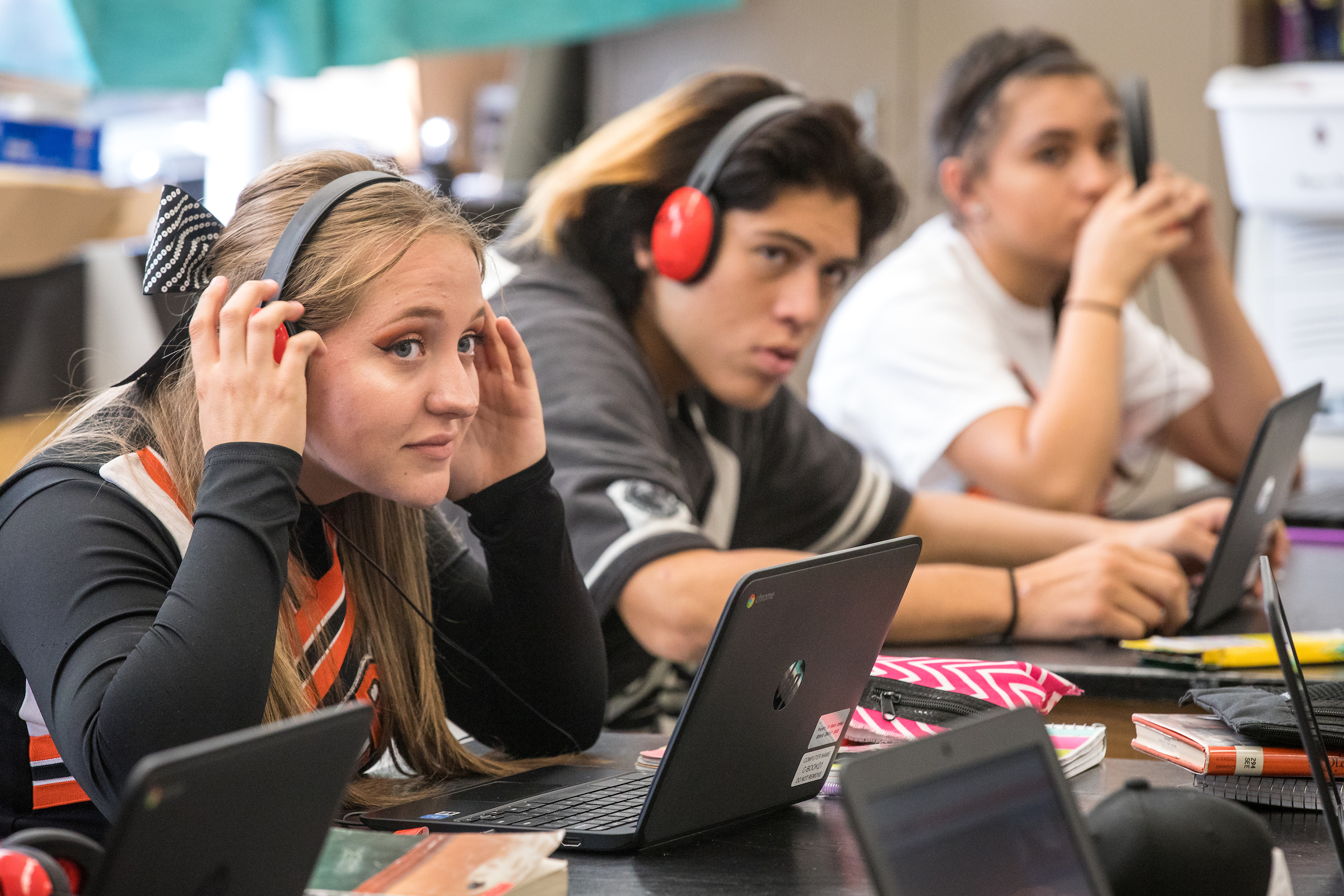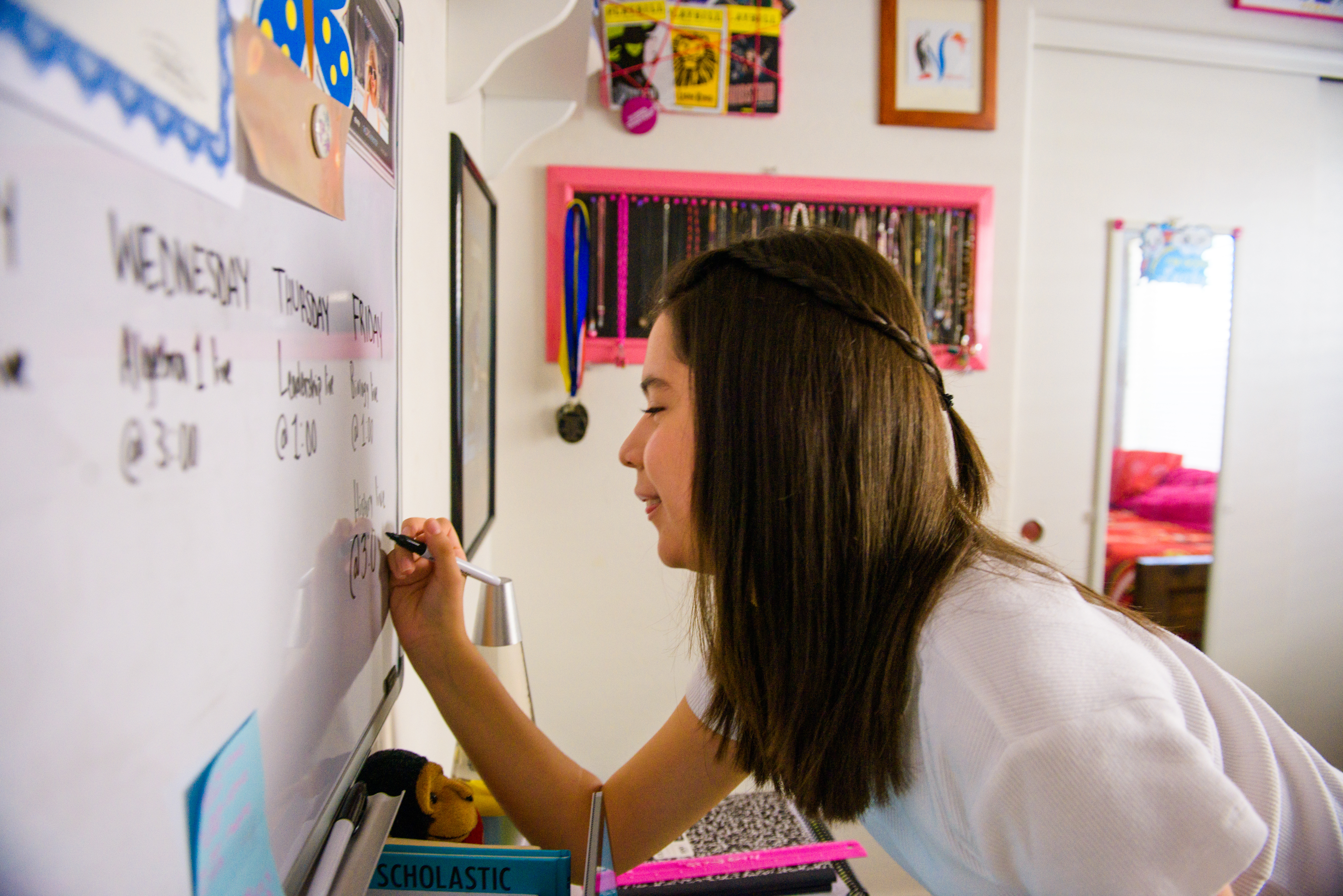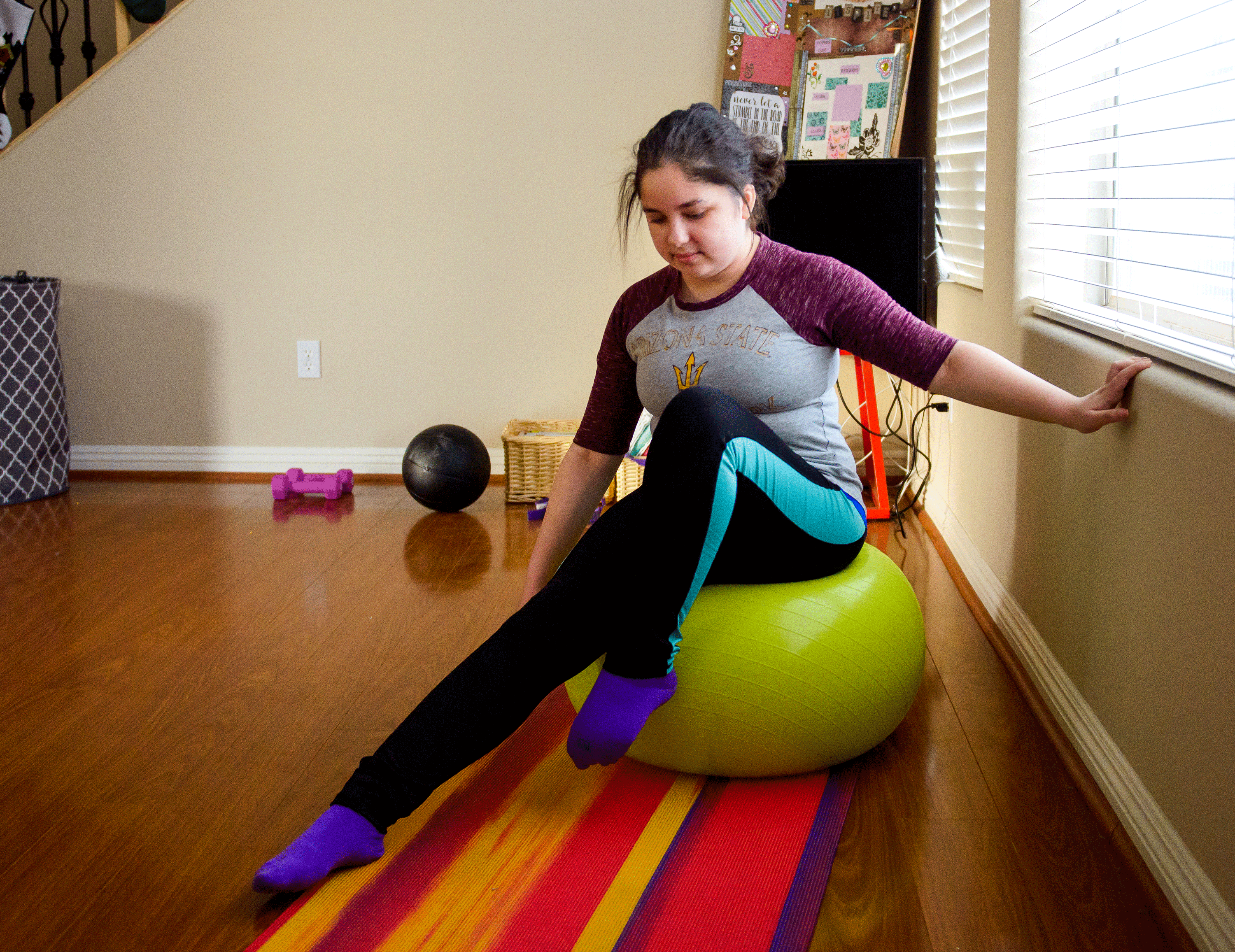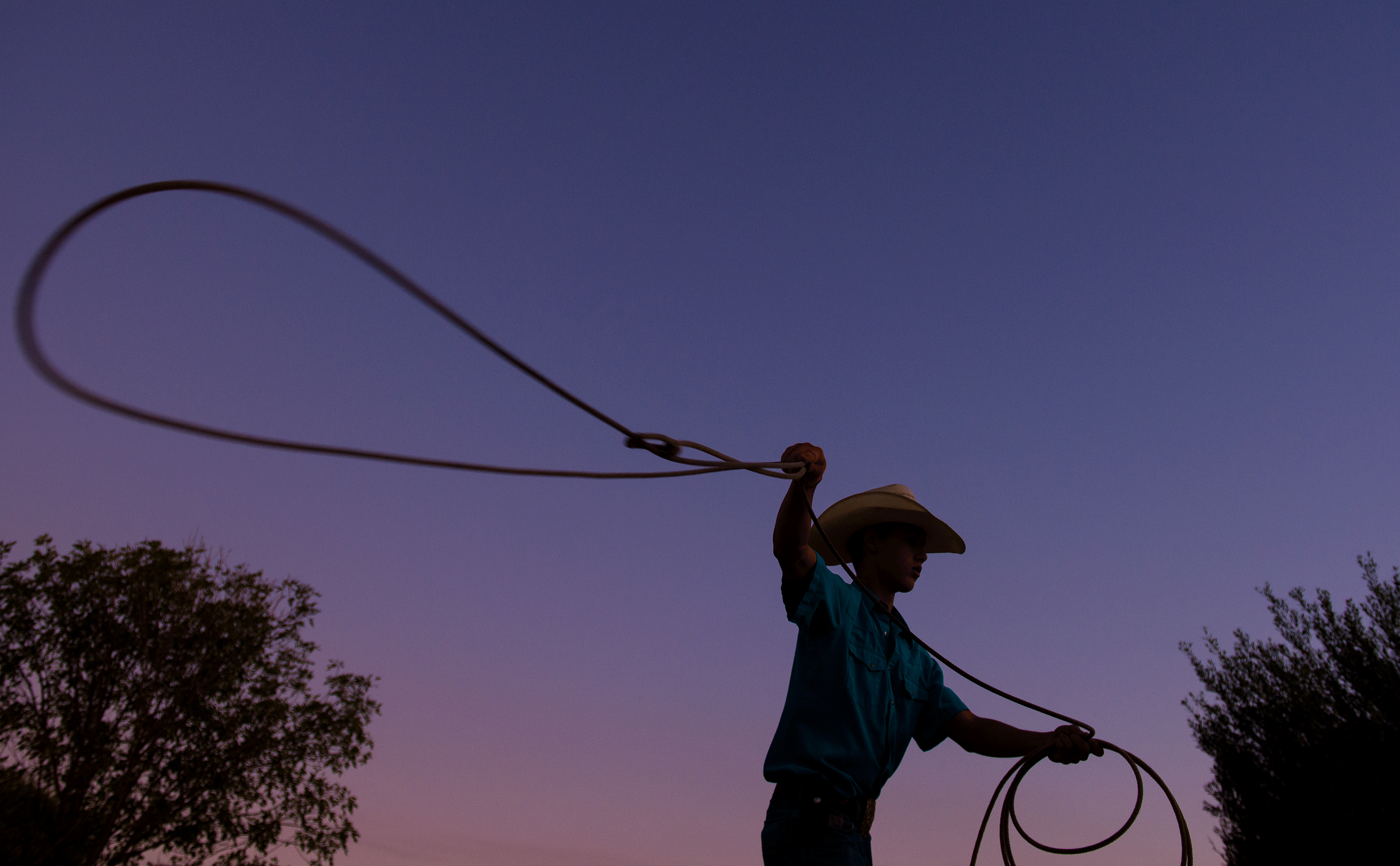Saddling up for a different kind of school
ASU Prep Digital’s slate of online classes gives high schoolers room to move fast, to heal — and even to rope a few calves
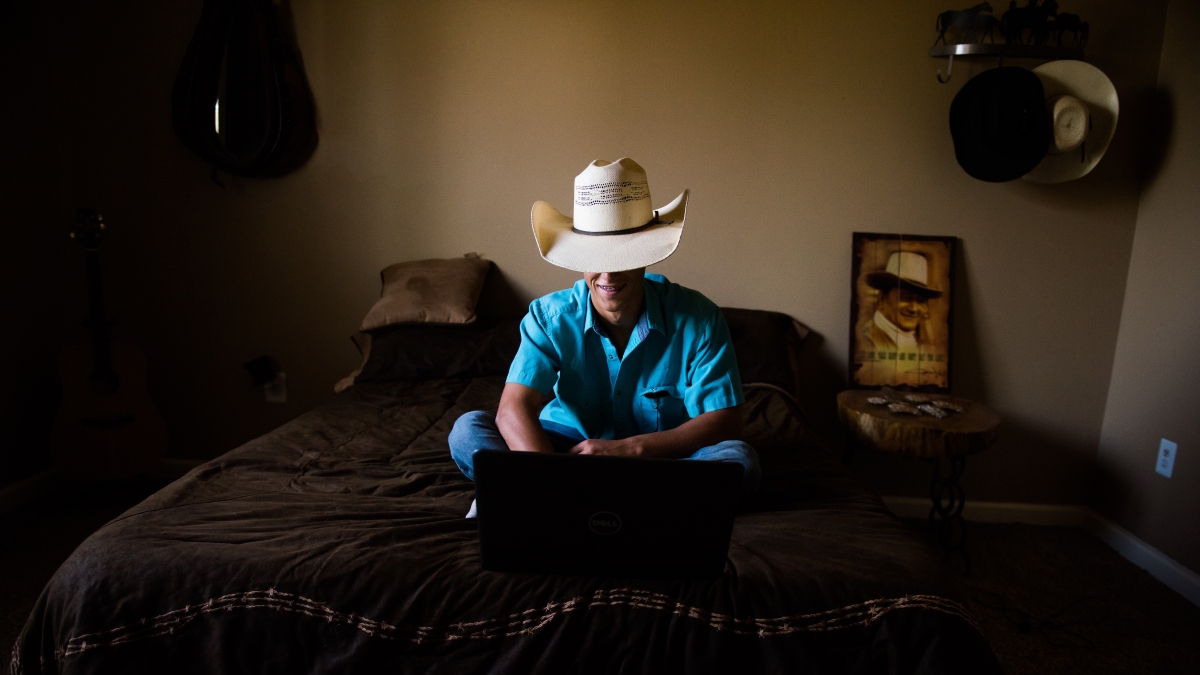
Update, fall 2018: After 18 months of ASU Prep Digital’s working with Miami High School, students there on average scored 30-plus points higher on benchmark tests in math and biology.
———
The chickens are clucking and the sun has yet to emerge over the cotton fields around Coolidge, Arizona, but Hunter Kelley is already busy.
He has to collect the eggs, feed the horses, cattle and other livestock. He has a rope in his hand — he always has a rope in his hand — and big ideas about the future in his 15-year-old head. Studies have to wait for the tall, lean boy.
A world away in South Phoenix, a big day awaits Nalani Monenerkit at her family’s stucco bungalow. She’s turning 14. A large Spider-Man “Happy Birthday, Nalani” banner hangs over the kitchen table.
After breakfast, she’ll walk down the hall, its walls filled with her artwork and school portraits. The girl with the long dark hair will plant herself in a plain metal swivel chair and dive into her online coursework. She’ll be fixed there, in her T-shirt and jeans with the holes in the knees, at a modest desk in her small bedroom for hours without break.
Nalani’s ideas about the future are less crystalline. She’s still trying to figure out high school.
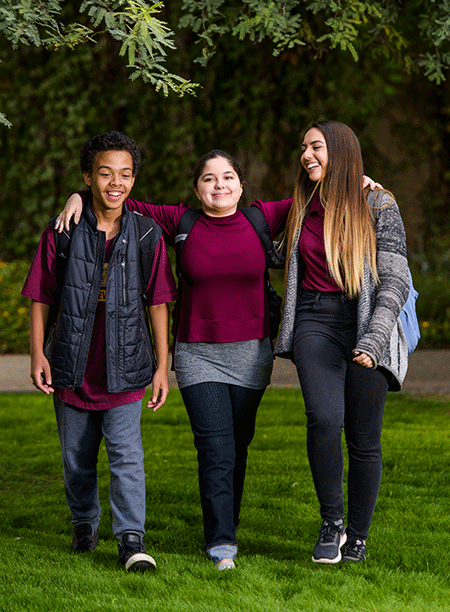
Maya Rodriguez (center, with fellow freshmen Joshua Ramos and Anna Bacarella at ASU Prep Poly charter school in Mesa) is one of the students benefiting from the flexibility of combining online courses with those at her brick-and-mortar school. Photo by Jarod Opperman/ASU
In nearby Queen Creek, Maya Rodriguez is awake ahead of a tiring day. She readies for the trek from the big suburban house on a cul-de-sac to Phoenix Children’s Hospital. That’s where she attends routine occupational and physical therapy sessions. They are both her burden and her inspiration.
Maya, still just 14, has big ideas for her future, too, but to get there she needs a little help in school.
Enter ASU Prep Digital, a slate of online high school classes, a new initiative of ASU Preparatory Academy, innovative charter schools with an emphasis on providing premium environments for learning. Those are a bridge for Maya. They help her complete her studies when her medical condition wears her down in the classroom.
ASU Prep Digital, introduced in August, offers these young students and hundreds more like them choice. Independence. Flexibility. Futures. The online high school coursework enables students to take as many or as few classes as they want, when they want and where they need.
For some, that’s not always a traditional classroom.
Yet traditional classrooms sparked the idea. Arizona State University looked at its prep schools around the region, saw what worked and wondered why high schoolers couldn’t prepare for college just as well if they took the same courses online.
The prep academies were like a dandelion flower, its seeds drifting into the homes of Hunter, Maya, Nalani and hundreds more in Arizona. Seeds took root around the country and the world. The idea germinated in classrooms within seven Arizona school districts, places like Miami where rural school administrators struggle with threadbare resources.
For students, educators and ASU itself, ASU Prep Digital represents a nascent experiment, an education lab. The people running the program don’t like that word, experiment. It smacks of uncertainty. They prefer “prototype.” There is a strategy.
For them, the goal is to help reinvent learning in Arizona and grant students who may someday enroll in a university a better chance to succeed once they arrive.
For the youngsters enrolled in ASU Prep Digital, the experience resembles a tryout. Hunter, Maya and Nalani all say they hadn’t been certain what to expect.
Meeting different needs
For 15-year-old Hunter Kelley (pictured here and at the top of this story) of Coolidge, Arizona, ASU Prep Digital offers flexibility, freeing up time for him to practice rodeo skills for the competitive circuit. Photo by Jarod Opperman/ASU
Each teenager discovered ASU Prep Digital differently. Each needed something different. But all three wanted something better than they had.
Hunter wanted a more flexible schedule. When his guidance counselor told him about ASU Prep Digital, he saw a perfect fit.
“This relieves all the stress because now I can do all my work ahead,” he explains.
That frees up time to drill at roping calves, riding bulls and other rodeo skills — skills that can earn big prize money.
Nalani needed a better place to learn. In junior high school, she wanted to learn at her own, faster pace. The teachers had to balance fast and slow learners. Disruptions made matters worse.
“I felt I was being held back and it was moving at too slow a pace,” she says. “This is quieter. It’s more designed to work for an individual student.”
At first, when she and her mother attended a presentation, she had doubts about studying at home exclusively. She changed her mind.
“I was excited to do it. Some of my family was concerned about my social life,” Nalani says, but she has had plenty of time for both studies and friends.
Pace posed a different challenge for Maya. She lives with multiple sclerosis, and with it comes chronic fatigue, nerve pain and medicine that causes drowsiness.
“School was pretty hectic,” she says of her life at ASU Prep Poly High School, a charter school in Mesa. She placed in advanced classes but opted out. “I would have gotten too far behind.”
With online classes, she can pace herself, rest if necessary, and continue learning. When her Poly teachers told her she could mix her classes, it made perfect sense.
ASU, too, saw opportunity. The university could better serve driven students and those at resource-starved rural schools.
“We partner with superintendents to fill those gaps. For instance, it’s hard to find highly qualified physics teachers,” explains Amy McGrath, chief operating officer for ASU Prep Digital.
The university brought her and CEO Julie Young on board last January, after they introduced a similar concept in Florida.
Janaya Sullivan (left) looks at the large monitor at the front of the class as students log into the ASU Prep Digital lesson in biology class at Miami Junior-Senior High School. Photo by Charlie Leight/ASU Now
In Miami, a mining town of around 2,000 people tucked in the mountains 80 miles east of Phoenix, Glen Lineberry discovered ASU’s efforts in meetings about addressing the state’s teacher-shortage crisis.
The principal of the Miami Junior-Senior High School jumped at the idea.
“A lot of the kids here come from pretty difficult situations,” Lineberry says.
One in five residents lives below the poverty line, U.S. Census Bureau data show. One in four never finished high school, and fewer than half went any farther.
Along U.S. 60, the boarded-up storefronts tell much of the story.
The school runs on less money than it had a decade ago, even after inflation, Lineberry says. His teachers explain history and economics with books written before 9/11 or the Great Recession.
ASU Digital Prep offered the chance to plug a gap — qualified teachers in biology and English at the sophomore level. Students take the certified ASU online classes, but with a teacher in the room “leading the class.” This is blended learning.
“The advantage for ASU is to have a friendly lab to work in," a real-life place to try it, Lineberry says.
What a day is like
It’s early afternoon on a recent Thursday and Hunter Kelley is cantering across a dirt field on a brown horse. He’s back at home after roping calves at the Lonestar Equestrian Center for two hours.
Hank, a gray, blue-eyed hound; and Zoe, a small black-and-white Toy Aussie, trot across the drive to greet him. Hunter is wearing a white straw Stetson hat, a blue button-down shirt, boots with spurs and jeans with gloves tucked in the back pocket.
He offers a tour of the 5-acre farm at the end of the gravel road. Here sits a bucking barrel. The Kelleys fashioned it from a 55-gallon drum, galvanized pipe and springs. After dinner, Hunter will mount the contraption and his brother will pump it to resemble the jerking of a bucking bull.
Around the corner lies a disused alfalfa field next to the cow pasture. The family drove recycled oil pipes into the ground to form the perimeter of a practice rodeo arena.
As he walks into the large house with vaulted ceilings and custom timber posts, Hunter is still twirling his practice rope. “I rope anything with a pulse. I’ll rope the chickens,” he says, showing a smile with braces.
After a ham and cheese sandwich, Hunter heads into his bedroom to study. It’s all wood and metal, in hues of brown and tan. Homage to the West.
A half-dozen cowboy hats hang on racks and elk horns. A painted wooden poster of John Wayne sits on the bedside table framing the gleaming rodeo belt buckles.
Hunter lays stomach-down on the bed, unfolds his laptop and begins today’s online lessons. He’s still wearing his hat, but that doesn’t stop him from being the only student in his leadership class to communicate by video. The other dozen students type their answers into a chat board. His instructor's voice over the computer praises him for courage.
The history lesson entails analyzing photos from the Battle of Wounded Knee, differentiating between the objective observation of bodies in a ditch and the subjective interpretation that they had been massacred and dumped.
Hunter runs through his exercises quickly, once calling a teacher on his cellphone to clarify an assignment. Hours later he’s done and planning an evening of rodeo, dinner, more roping on another dummy in the yard and an hour on the bucking barrel.
“At ASU they say: ‘Eat the frogs for breakfast,’ meaning, get the hardest assignments done first,” Hunter says. “You have to be self-disciplined to do online school.”
Nalani Monenerkit is.
It’s her birthday, but she’s not texting friends. Inside her home in South Phoenix, she’s at the small desk in her bedroom, working. Silently. For hours. Without pause.
Nalani Monenerkit, 14, updates her schedule on a whiteboard in her South Phoenix bedroom. She's taking six classes through ASU Prep Digital, and the pace suits her. Photo by Jarod Opperman/ASU
She’s taking biology, history, leadership, algebra, English and Spanish.
Above the tidy desk, a dry-erase board hangs on the wall. She has written the schedule for all her live sessions for the rest of the week.
Today is biology. The teacher plays a short documentary with David Attenborough explaining the sustainability of the planet. It’s the first time Nalani has joined this live lesson, which lasts about an hour.
The teacher directs the lesson from live streaming video, seen in one panel on the screen. The lesson is in the middle. Communication happens in a separate chat box.
After the video, Nalani answers a question about what she took away from the clip. She says Earth could sustain only 1.5 billion people living the lifestyle of the typical U.S. resident.
“Nalani, I like yours,” the teacher says. Nalani writes down all the questions on sticky notes before she answers them online.
In history, she’s asked to copy the PowerPoint text about European explorers. In handwriting that never strays over the lines, she complies, and slips the paper in a color-coded binder. No papers stick out.
And so it goes — math, English and so on, as a row of Cabbage Patch dolls looks down from a shelf overhead. The only sound is the hum of the small desk fan and gentle taps on the keyboard.
Nalani has more stamina than her grandmother, who retires to the bedroom across the hall. After homework, the two will chat, play with the dog or go to the park. No mention of birthday plans. She’ll hang out with friends on the weekend, she says.
“It’s not a damper on my social life,” Nalani says of studying at home full time. “I’m pretty happy with it.”
For Maya Rodriguez, most days are more structured. She takes only algebra and English online; her four other classes are with the other freshmen at Poly.
She’s out the door by 9 a.m. On this day, it's Halloween. Pumpkins line the porch behind spiderwebs and lawn decorations. It’s the kind of neighborhood where 100 kids might show up for trick-or-treat, says Maya’s mother, Grisele Rodriguez.
Today, Maya exchanges the obligatory ASU maroon uniform polo for an ensemble of black sweats and huge round glasses. She’s aiming for Edna Mode from “The Incredibles.” With her shoulder-length brown hair and round face, she pulls it off.
She shoulders her floral backpack and jumps in the blue Honda Fit for the five-minute drive to school.
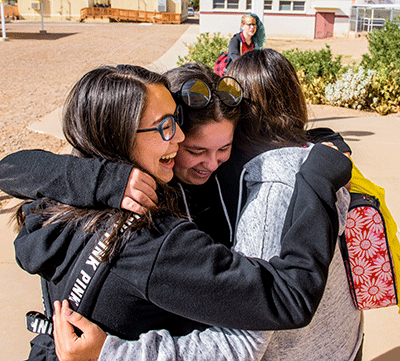
Maya Rodriguez (center) greets friends at ASU Prep Polytechnic in Mesa. The 14-year-old takes most of her classes in person, but ASU Prep Digital's algebra and English courses allow her to complete her studies when multiple sclerosis wears her down. Photo by Jarod Opperman/ASU
She walks through the glass doors and onto the colorful linoleum floors of Sacaton Hall. A flood of students arrives all at once, breaking the quiet. Some see Maya. A boy says hi. A girl with braids gives her a hug.
Then she’s off to Room 105, where 16 students scattered around square tables will be learning about DNA and mitosis, while Maya — as a “guest student” doing independent study — sits at a table near the corner and practices algebra.
She flips open her silver Chromebook and logs in. She shows another independent-study girl a picture on her iPhone explaining her costume. She has already taken off the bug-eye spectacles, even as other students show off and chatter about their costumes.
The class quiets down. Only the teacher’s voice and the hum of the air conditioner are audible. Maya is wrestling with an algebraic equation full of fractions.
She pulls out a green pen and scribbles formulas on the table, coated with a white dry-erase board. After a few cross-outs, erasures and pauses, the computer program ALEKS tells her she’s ready to move on.
So it goes for most of the 90-minute period. Occasionally Maya gets distracted by the biology lesson, or students discussing the cloning of dogs. Maya smiles quietly and giggles at some of their goofy comments, and then sweats out another equation.
Some mornings, especially after therapy, Maya is too fatigued for independent study. She catches up at home.
“I wasn’t too sure about it at first, because I thought online school would be full time and I didn’t know if I was OK staying home all day and not spending time with my friends,” she says. “Later I learned I could do a hybrid program, and I thought that was pretty cool.”
Maya is one of more than 900 students enrolled in ASU Prep Digital classes. The school launched in August and offers options to take all or some high school courses online.
In Miami, the idea is catching
“It’s going really well. The kids really like it,” Lineberry, the Miami principal, says. “They get that this is a big leap for us.”
He adds that “not every 15- or 16-year-old kid has the self-discipline,” and that leaving them alone with computers and no guidance would have been a mistake.
A group of four sophomores and freshmen all say they prefer the blended online classes.
“I like that you have access to it in and out of class and you have two sources for each class: your teacher and the web. I prefer when the teacher is there because they can answer a question right away,” says freshman Katelin Followill, 15.
Jayden Gross, 16; Riley Guthrey, 14; and Mycala Stapleton, 16; all nod in agreement.
All four say they are learning English and biology faster than they would in a regular class.
Future ambitions
In his bedroom window, Hunter keeps a notecard with a quote from John Wayne.
“Courage is being scared to death and saddling up anyway,” it reads.
Hunter is saddling up. ASU Prep Digital enables him to pursue his dream of being a champion rodeo competitor and running his own business, just to bring in steady income.
“With this, I can do my work on the road. I have a hotspot and I can do my work anywhere on a laptop,” he says. When he recently traveled to a rodeo contest in Phoenix, he finished his work in the car.
That’s the difference between perfecting his craft and not. He planned to compete in a national rodeo contest in Las Vegas in December.
If Hunter were still full time at Florence High School, “I’d have to miss out,” he says. Instead, he’s getting several hours of rodeo practice in a day and plans to take college-credit courses through ASU Prep Digital toward a business degree after high school.
Nalani hasn’t decided on her future yet. She knows she wants to go to ASU. The playbills on her wall show her love of theater. Her mother, Verna Monenerkit, says Nalani drives herself hard and has talked about a career as a lawyer, a fashion designer or both.
Nalani can’t articulate yet what ASU Prep Digital means to her. But she’s clear on what life would be without it.
“I probably would have been really bored and slacked on academics, and not really done too well,” she says. “I probably wouldn’t have been interested in ASU. Before, I didn’t really know where I wanted to go.”
Online courses are a bridge for Maya Rodriguez of Queen Creek, allowing her to keep up while attending routine occupational and physical therapy sessions. Photo by Jarod Opperman/ASU
For Maya, it’s all about what’s possible now. “It means the world to me,” Maya says.
“It gives me the flexibility I need to make my education whole,” she adds. “If this works out the way I want it to, I’ll have time to do everything to learn, to heal, to learn how to help myself and to learn how to cope with everything.”
Inspired by her therapists at Phoenix Children’s Hospital, Maya wants to be a children’s occupational therapist herself. Her visits are her salvation.
“My break is going to my appointments and doing my stretches and working out and having fun and seeing all the little kids doing the same things as me,” Maya says. “When you walk in there, your heart just melts to see all the babies.”
She can picture how her goal is attainable, even if she might have to take longer to get there.
But ASU Prep Digital is not exclusively focused on the self-disciplined, hard-driving kids like Maya, Nalani and Hunter. Administrators such as McGrath have plans, too.
Her goal is to sign up 15,000 enrollments by August 2018, a tenfold increase over the current target. A year later, she aims for 20,000.
In addition to the part- and full-time online students, ASU also wants to grow the ranks of blended classroom students.
The university is not just offering those “gap” classes to help struggling high schools bring in subject experts. ASU Prep Digital offers 50 high school classes, ranging from freshman to senior level, in courses that include Arabic and psychology.
ASU Prep Digital is supported with state revenues for full-time Arizona students and a reduced tuition rate for part-time Arizona students. Students enrolling outside of Arizona or internationally pay tuition. Private philanthropy has also provided support to assist with early-stage development. In addition, ASU offers 70 college-level courses for a fee.
“It’s kind of unprecedented,” McGrath says. “We want to drive kids to (college) where they can succeed, to advance when ready, instead of being confined by a traditional school.”
Success will be measured by hitting national benchmarks for evaluating subject mastery.
“We are trying to illustrate what the future of education looks like,” McGrath says.
At Miami High School, Lineberry credits the university.
“We are meeting expectations and beginning to work on how to expand our curriculum,” he says, noting that online classes won’t end Arizona’s chronic teacher shortage, but they help.
The four freshmen and sophomores all say they plan to go to college. This is a town where one in 10 do, according to census data. Their parents, many current and former copper mine employees, want better for them.
“I’d like (ASU) to continue with it and keep the program going so people behind us can have a better future. Learning is a big part of your life. Kids will have a better future if they learn,” says Miami sophomore Jayden Goss.
Hunter Kelley twirls his practice rope. Photo by Jarod Opperman/ASU
Meeting students where they are
ASU Prep Digital is just one of the ways Arizona State University offers different approaches to college attainment.
Degree completion is a critical need in Arizona, where just 28 percent of adults age 25 and older hold a bachelor’s degree, according to the U.S. Census Bureau. ASU is working with the state in support of Achieve60AZ, an alliance of 60 community and business groups to make Arizona more competitive by supporting a goal of achieving 60 percent of adults, ages 25–64, with a professional certificate or college degree by 2030.
By 2020, 68 percent of all jobs in Arizona will require some form of postsecondary education, according to the Georgetown University Center on Education and the Workforce.
Recognizing that flexibility is a top priority, ASU offers several pathways to a bachelor's degree.
Global Freshman Academy: Students can choose among 14 freshman-level courses, such as pre-calculus, English 101 and Introduction to Solar System Astronomy, tuition-free. If they pass a course, they can then choose to pay for ASU credit.
Transfer pathways: The Maricopa-ASU Pathways Program, or MAPP, specifies exactly which courses are needed for each major at ASU, so that community college students can avoid wasting time and money on classes that don’t apply to a degree. Students who meet the requirements are guaranteed admission. ASU also has transfer pathways with other Arizona community colleges, including tribal colleges, as well as institutions in California and other states.
Concurrent enrollment programs: ASU partners with the Maricopa Community Colleges in a program to accelerate the path to a bachelor of science in nursing, requiring only one semester beyond an associate degree.
Stay-in-place in rural Arizona: ASU partners with three institutions in rural areas to offer a handful of bachelor’s degrees on a community college campus: Eastern Arizona College in Thatcher, Arizona Western College in Yuma and Central Arizona College in Coolidge.
Fast-track degrees: For students who are looking to finish quickly, there are 18 degree options that can be completed in two and a half or three years.
Written by Sean Holstege. Top photo by Jarod Opperman/ASU. This story appeared in the January 2018 issue of ASU Thrive magazine.
More Science and technology

ASU author puts the fun in preparing for the apocalypse
The idea of an apocalypse was once only the stuff of science fiction — like in “Dawn of the Dead” or “I Am Legend.” However these days, amid escalating global conflicts and the prospect of a nuclear…

Meet student researchers solving real-world challenges
Developing sustainable solar energy solutions, deploying fungi to support soils affected by wildfire, making space education more accessible and using machine learning for semiconductor material…

Miss Arizona, computer science major wants to inspire children to combine code and creativity
Editor’s note: This story is part of a series of profiles of notable spring 2024 graduates. “It’s bittersweet.” That’s how Tiffany Ticlo describes reaching this milestone. In May, she will graduate…

